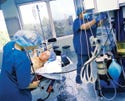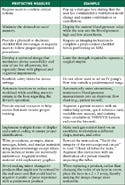Defining and Designing for Worst-Case Users
Originally Published MDDI July 2006 PRODUCT DEVELOPMENT INSIGHTUnderstanding common limitations of potential device users can help designers develop devices with safe and effective user interfaces.
July 1, 2006
PRODUCT DEVELOPMENT INSIGHT
|
Although a medical device must tolerate electrical surges and fluid spills, it must also withstand the actions and inactions of unprepared, unfit, or impaired users. Disconcertingly, such users can be found in nearly every hospital job. An inexperienced technician who is a week removed from his previous job in an unrelated field would be one example of such a user. A 20-year veteran physician who has worked a particularly long day and lost the ability to concentrate would be another. Or such a user could be a layperson with multiple physical and mental impairments. Such individuals might unintentionally forget procedural steps, overlook critical indications, transpose numbers as they input settings, or press the wrong buttons. The consequences of these and other kinds of use error depend on the device's user-interface design characteristics and related safety features.
For example, a built-in software wizard (i.e., a series of instructional screens) could keep users on the right procedural course, particularly if it is complemented by interlocks that preclude hazardous actions. Or a device could alert users when they set a particular parameter, such as a fluid flow rate, above a predetermined safety limit. The device might request confirmation or even reject the value altogether.
However, it is challenging to design a protective and error-tolerant user interface that keeps users, such as healthcare professionals and patients, out of trouble. It requires a thorough understanding of prospective users' possible shortcomings. In other words, it forces product developers to define the characteristics of worst-case users.
User Shortcomings
A worst-case user—an admittedly artificial and pejorative construct—is an amalgam of many shortcomings that are unlikely to exist in a single individual. Some of the most significant shortcomings, which might be temporary or permanent, are described in this article.
When reviewing the shortcomings, it is crucial to note that many of them can result from a system that places insufficient emphasis on safety and may actually induce errors. In other words, the users might not be to blame. Other shortcomings are organic, relating to individual personality and habit.
The ultimate goal here is not to assign blame but rather to recognize reality. Designers should be aware that device users are not uniformly trained, motivated, vigilant, or able-bodied. Although assuming that all users are competent device operators might simplify the design process, it is also likely to lead to problems in the field that could cause injury and death, as reflected in numerous Medical Device Reports.1 Many are summarized under the topic user errors and can be found online in ECRI's Medical Device Safety Reports database at www.mdsr.ecri.org.
Fatigue. There are numerous stories about medical personnel delivering patient care when they are thoroughly exhausted. In fact, in the past, the medical system would systematically exhaust its younger workers (e.g., interns) by requiring them to work extended shifts. It was a trial-by-fire training regimen intended to harden professional newcomers and control costs by using cheap labor.
Yet sleep deprivation studies have demonstrated the hazard of tired caregivers. In response, medical institutions have begun to limit the number of hours worked, prompted by confirmation that exhausted people make more mistakes.2 In fact, recent studies have equated the negative effects of fatigue on medical practice to the negative effects of alcohol consumption on driving ability.3
Possible mistakes related to drowsiness run the gamut from poor decision making (e.g., skipping a safety check) to physical miscues (e.g., placing a surgical staple in a suboptimal location). Also, there is the distinct possibility that tired workers will fall asleep, leading to errors of omission, such as allowing alarm conditions to develop and worsen due to prolonged inattention.
|
Nurses and other caregivers are often expected to operate numerous devices, as well as different models of devices, on a regular basis. A lack of knowledge about how to use such devices may lead to use errors. |
Lack of Operational Knowledge. Inadequate training among certain healthcare workers on the use of technology appears to be epidemic. Currently, a large proportion of nurses face a daunting challenge just getting their regular work done, like filling out piles of documentation, never mind finding the time to participate in group or self-paced training sessions. The problem is exacerbated by the continuous flow of new technology into care environments, extended periods of time between training opportunities, protracted periods between training and use, and the prevalence of part-time and temporary working arrangements. In short, healthcare workers do not always have the opportunity to receive proper and well-timed device training.
To judge the scale of the problem, consider that intensive-care nurses need to learn to monitor and operate one or more models of intravenous infusion pump, syringe pump, balloon pump, ventilator, patient monitor, dialysis machine, blood warmer, blood analyzer, hospital bed, medication dispenser, recordkeeping system, and lab reporting system—and that's an abbreviated list. Often, they will not have time to become fully familiarized with these and other devices before being pressed to use them. More likely, they will be able to attend only some of the manufacturers' and nurse educators' in-service presentations, which might last about a half hour. In lieu of structured training, nurses will try using a device based on their experience with similar devices and intuition, seeking help from any available colleague who might be more familiar with the technology.
That said, some institutions require their nurses to complete a certification course to operate a given device. But this is not a universal practice, despite many manufacturers favoring device training as a prerequisite for device use. They see it as a measure of protection against use errors that could lead to adverse events and product liability claims.
But even if nurses attend a certification course, it may not provide that extra level of protection. Certification processes are meant to demonstrate nurses' competency using a device. Sometimes the proof of training is no more than an attendance sheet that only shows that the given nurse has attended the training; yet he or she is thereafter certified to use the device.
Other types of device users might have no more time or patience for training than nurses. For example, occasionally physicians might skip formal training in favor of figuring things out on their own, sometimes over the course of using the device for the first few times. In such cases, physicians figure they can ask a colleague for help if necessary. However, they then might be hesitant to seek assistance because it makes them look incapable. (This problem, however, has been addressed more recently through crew resource management training.4)
Laypersons might receive 10 minutes of training to use a glucose meter during a visit to the doctor's office, for example, but then forget what they learned when they get home. In those cases, they might also try to figure things out on their own, particularly if self-discovery is their preferred learning style, which could lead to use errors.
On a positive note, biomedical technicians seem more likely to participate in training events and to study user manuals. This willingness may stem from their personal nature as well as professional responsibility to master device operations. It also explains why they get so many calls from caregivers who have trouble using a medical device, and why they sometimes provide formal training to others.
Divided Attention. High workload can certainly degrade human performance. Too much work means there is less time to gather and process information, complete each step of an established procedure, or perform necessary double checks. Instead, caregivers must form a quick impression of the prevailing conditions, perhaps take a procedural shortcut or two, and move on to the next item on their triage list. Although desirable, double-checking one's work becomes an unaffordable luxury in the minds of many users. Therefore, detectable problems remain undetected until a small problem becomes a larger one.
Distraction. Distractions are abundant in most healthcare environments and an ever-present threat to safe and effective user-device interaction. Here are just a few of the common distractions found in medical environments:
• Phone calls and overhead pages (information requests from staff, patients, and family).
• People moving about the workspace (medication deliveries, maintenance chores, blood draws, etc.).
• Conversations among staff and patients.
• Medical emergencies (patient falls, cardiac arrests, delirium, etc.).
• Equipment noise (sound generated by pumps, valves, fans, transformers, etc.).
• Alerts and alarms (various signals from monitoring, diagnostic, therapeutic, and office equipment).
People working in ambulances and field treatment sites can be distracted by crowds of people, automobile traffic, sirens, and other environmental factors.
Some caregivers are good at blocking out distractions and can concentrate fully on the task at hand. Others are less capable of tuning out distractions. Interestingly, it is not clear which type of caregiver is more vulnerable to certain kinds of use error. For instance, deep concentration might help a nurse complete an important procedure. However, fixation on one task might hinder a caregiver's ability to notice other environmental stimuli, such as a blood pressure monitor alarm. Therefore, designers need to consider both cases.
USER PROFILES
A typical user profile may include information about a fictional person in an attempt to create a worst-case user. One example is the following: Fred Johnson |
Absentmindedness. The notion of caregivers behaving in an absentminded fashion is disturbing. No one wants to think that a physician, therapist, nurse, or technician would act inattentively. But as one experienced dialysis technician who trains nurses stated, “There are many nurses who can function in an absentminded manner. They are the types who don't always practice aseptic technique.” The threat of absentminded device use also applies to laypersons that use a medical device at home, away from an institutional setting in which people watch out for each other.
In either a professional or nonprofessional setting, absentmindedness can develop. Overconfidence in one's capabilities can interfere with problem recognition and resolution. Of course, we all know people who seem absentminded by nature. They neglect to change the oil in their car, leave candles burning at night, and ignore traffic signs, all of which can have significant consequences. It's an unfortunate fact that such individuals will join the ranks of more-careful healthcare workers.
Physical and Cognitive Impairment. Device users, including medical professionals and laypersons, will exhibit a wide range of physical limitations, such as arthritis, hearing and vision loss, muscle weakness, and even paralysis. They will also exhibit cognitive impairments, such as short-term memory problems, a common affliction among older individuals. After all, the recent U.S. Census determined that 18% of the adult population has a recognized disability, with 12% reporting a severe disability.5 For example, the early symptoms of Alzheimer's disease can make it difficult for users to remember a device's operational procedures. As another example, diabetics suffering from low blood sugar may feel disoriented, making it difficult to operate a glucose meter they have used competently for years. Consequently, they might misread the meter or perform a blood test incorrectly, leading to a medication error.
Additional kinds of disability may cause device users to have trouble with the following tasks, for the following reasons:
• Squeezing a pliers-type surgical tool with sufficient force (cumulative trauma disorder, arthritis, or Dupuytren's contracture).
• Reading the small print in an operator's manual (presbyopia, macular degeneration, or cataracts).
• Hearing a high-frequency alarm tone (presbycusis).
• Reaching a control placed particularly high or low on a vertical panel (paraplegia).
• Differentiating information coded red versus green (impaired color perception).
Limited Language and Literacy Skills. Nationwide, about 82% of the population speaks English as their first language.6 This leaves a substantial number of U.S. residents who speak another language—notably Spanish—as their first language. In addition, the proportion of Spanish speakers is likely to be higher in certain areas of the country, such as Southern California and Texas. Of course, many of these people will possess excellent English skills. In fact, their medical training might have been completely in English. Nevertheless, some will possess limited English skills. Consequently, these people might take more time to read information written in English or might misinterpret it. For example, a technician might not fully comprehend detailed online help content that explains textually how to set up a therapeutic machine.
Low literacy is a very different type of obstacle to effective communication. In short, some device users—usually laypersons—will not have the necessary reading ability because of a lack of education or a learning disability.
Negative Transfer of Experience. Once people become accustomed to using one particular device, it can be difficult to switch to another one that works a bit differently, which is often the case when a manufacturer introduces a replacement product. The cause of the difficulty is that people learn to perform tasks by rote. Just like a piano player who learns to play a song almost automatically, caregivers often rely on muscle memory to guide their interactions with a medical device. Therefore, problems arise when changing from one device to another, as if one were trying to play a piano with a new key arrangement. The problem can be most severe if the differences between the devices are subtle rather than dramatic. For example, two devices might employ a linear arrangement of six push buttons but swap the positions of the power on-off and alarm silence keys. This arguably minor difference could lead users to unwittingly turn off a device while trying to silence an alarm.
Defining Worst-Case Users
Designers can define the characteristics of a worst-case user using a bulleted list that reminds designers to protect against incompetence, regardless of the cause. Another approach is to develop user profiles, or personas, to guide a design effort. User profiles can take many forms. One form is a broad-based description of a hypothetical individual's life-style, physical characteristics, behaviors, etc. Some designers go as far as giving the person a fake name. Another form focuses more specifically on the factors specific to device interactions. The sidebar, “User Profiles,” on page 56 presents the profile of an individual with several characteristics requiring accommodation.
Such profiles could cite many other medical and behavioral factors that could pose user-interaction challenges. A few more are presented below (possible causes shown in parentheses):
Medical:
• Lack of sensation at fingertips (neuropathy).
• Hand and body tremor (Parkinson's disease, multiple sclerosis).
• Reading difficulties, including reversing the order of letters and numbers (dyslexia).
• Postural problems (various back ailments).
Nonmedical:
• Sloppy handwriting.
• Tendency to physically abuse equipment.
• Technology phobia.
• Failure to maintain situational awareness.
Protective Measures
|
Table I. (click to enlarge) Manufacturers can take many measures to protect against use errors. |
The best way to protect against the worst-case user depends heavily on the device, the users, and the use scenarios. Indeed, devices range from digital thermometers to patient monitors to MRI scanners; users range from laypersons to technicians to physicians; and use scenarios range from daily home use to one-time hospital use. Table I presents several possible protective measures. But they are just some of the measures against use errors that could be traced to user shortcomings and special needs. The key is first to define the worst-case user and then implement the necessary protections.
Conclusion
Although maintaining respect for device users is very important, it is also crucial to realize individual limitations. Surely, many limitations arise due to the nature of the medical system, which sometimes places users at a disadvantage by overworking them, for example. Still, some individual limitations are part of being human, such as inattention to detail (i.e., absentmindedness). Such limitations pose a risk to patient safety when they degrade the quality of user-device interactions. The risk might be that a medical professional will deliver the wrong dose of medication to a patient because of a device programming error. Or the risk might be that a layperson will obtain incorrect data from a blood test device because of a procedural miscue, again leading to improper medication dosing.
Defining possible user shortcomings is the first step toward protecting against device errors that can cause patient injury and death, as well as property damage. The second step is to apply established human factors principles to accommodate user limitations and guard against use error. The third step is to provide a means for users to detect and recover from use errors. Following this approach, developers should be able to limit the number of adverse events related to use error.
Michael Wiklund is president of Wiklund Research and Design Inc. (Concord, MA). He can be reached via e-mail at [email protected].
References
1. FDA Medical Device Reporting [online]; available from Internet: www.fda.gov/cdrh/mdr.
2. Steven W Lockley et al. “Effect of Reducing Interns' Weekly Work Hours on Sleep and Attentional Failures,” New England Journal of Medicine 351, no. 18 (2004): 1829–1837.
3. Drew Dawson and Phyllis Zee, “Work Hours and Reducing Fatigue-Related Risk: Good Research vs Good Policy,” Journal of the American Medical Association 294, no. 9 (2005): 1104–1106.
4. Laura Pizzi, Neil Goldfarb, and David Nash, “Crew Resource Management and Its Applications in Medicine,” in Making Health Care Safer: A Critical Analysis of Patient Safety Practices [online] (Rockville, MD: Agency for Healthcare Research and Quality [cited 19 June 2006]); available from Internet: www.ahcpr.gov/clinic/ptsafety/chap44.htm.
5. “More Than 50 Million Americans Report Some Level of Disability,” in U.S. Census Bureau News [online] (Washington, DC: U.S. Census Bureau [cited 19 June 2006]); available from Internet: www.census.gov/Press-Release/www/releases/archives/aging_population/006809.html.
6. “Languages in the United States,” in Wikipedia; available from Internet: http://en.wikipedia.org/wiki/Languages_in_the_United_States [cited 19 June 2006].
Copyright ©2006 Medical Device & Diagnostic Industry
You May Also Like





